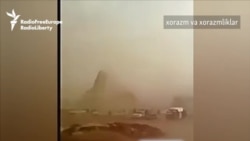On December 17, Turkmen President Gurbanguly Berdymukhammedov was conducting one of his "video-selector" sessions of the government, the kind he has grown fond of lately.
He was sitting behind a desk. There was a wall of TV monitors in front of him. On each screen was a different minister or deputy minister, assiduously writing down everything the president said -- Berdymukhammedov is fond of that, too -- and trying not to cower too much when it was their turn to report.
That day, cabinet Deputy Chairman Esenmyrat Orazgeldiev reported that Turkmenistan had harvested some 1.099 million tons of cotton when the target figure was just 1.050 tons.
The Turkmen opposition website Khronika Turkmenistana has since alleged that that figure and others are simply untrue. The site said it had obtained records from the Agriculture and Water Resources Ministry, though it did not say how, that showed the actual amount of cotton gathered in 2018 was some 450,000 tons, or less than half the reported total.
The site also claimed the wheat harvest failed to meet the government's target of 1.6 million tons and was instead some 538,000 tons, 30 percent of which was unfit for consumption.
If the figures Khronika cites are accurate, it would not be the first time the Turkmen government has made dubious claims. Qishloq Ovozi has already looked at some of that history.
But this time there are some significant underlying factors that could have contributed to a disappointing harvest.
Parts of Turkmenistan saw torrential rains in early May, followed by a freak salt storm later in the month caused by high winds lifting alkaline soil from the desiccated Aral Sea and depositing it on land, and crops, in northern and eastern Turkmenistan. A similar storm of lesser intensity reportedly hit the region again in July.
It was obvious the 2018 harvest in Turkmenistan would be less than planned.
And it might seem obvious now to the people of Turkmenistan that the wheat harvest did not meet expectations. RFE/RL's Turkmen Service, known locally as Azatlyk, has been following a continual rise in prices for flour and bread and the gradual rationing of those items and more for the past three years.
A sad thought is that any resulting hardship might be unnecessary. Damage that cotton and wheat crops sustained from the salt storms need not have been any fault of the government's. It would not be difficult to ask for international assistance to help feed the population.
But acknowledging that there was any sort of problem could blow a hole through the image the government and state media constantly project of Turkmenistan as a paradise.
And for the Turkmen government, image is everything.
Watching Turkmen state TV or visiting the website of the Agriculture Ministry, one could get the impression the fields are tended by teams of shiny tractors rolling side by side across the rich cropland. The reality is that thousands of people are forced into the fields, and photos that activists manage to take (at great personal risk) do not show any tractors moving behind the large groups of conscripted laborers.
Judging by state TV, stores around the country are overflowing with choice goods at reasonable prices. Reports of lines for flour and bread seem to tell a different story.
Heck, Turkmen state TV also seems eager to present the country's president as a genius, an athlete, a warrior, a musician, and a genuine man of the people.
Unfortunately, the Turkmen government is unlikely to ever make public the precise harvest data for 2018, and there is no way to independently verify the figures. So 1.099 million tons of cotton, and 1.6 million tons of wheat it is -- officially, anyway.









